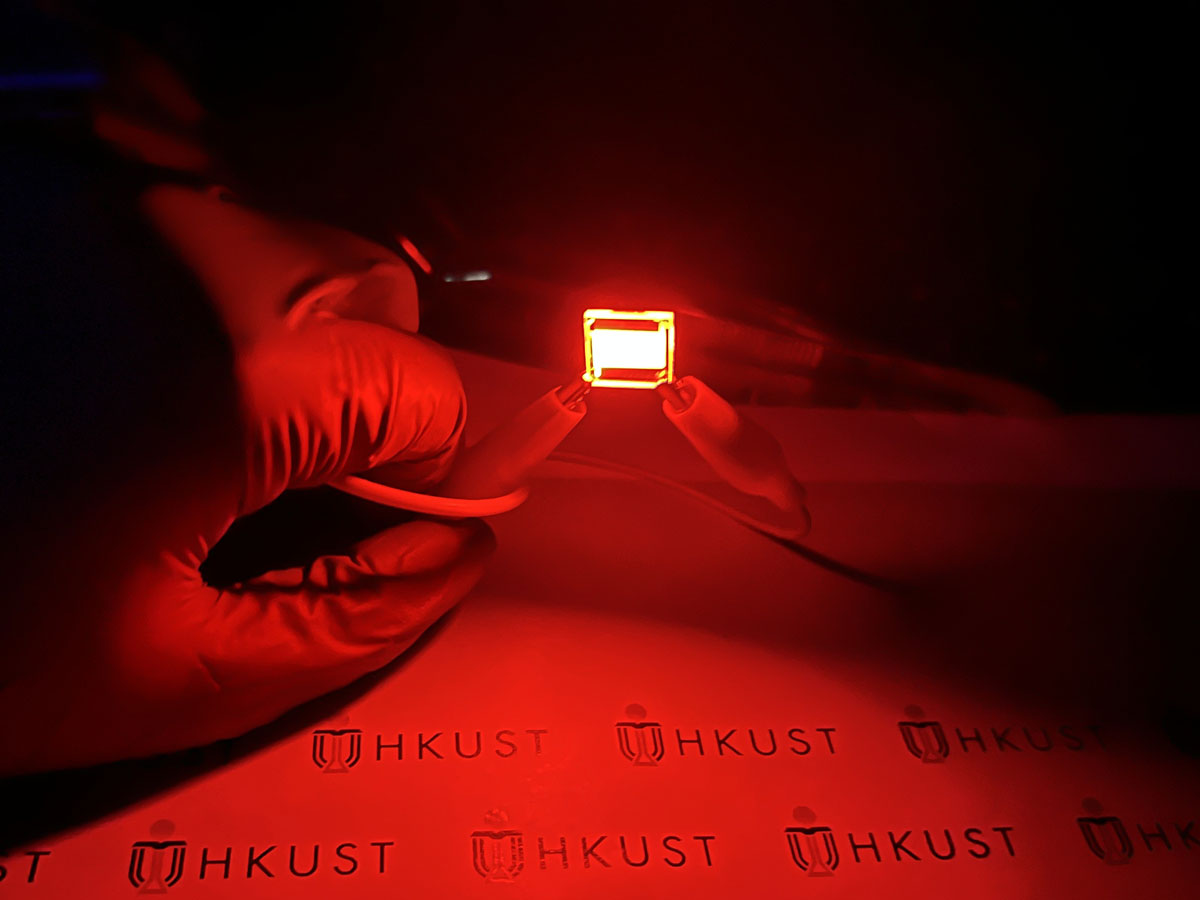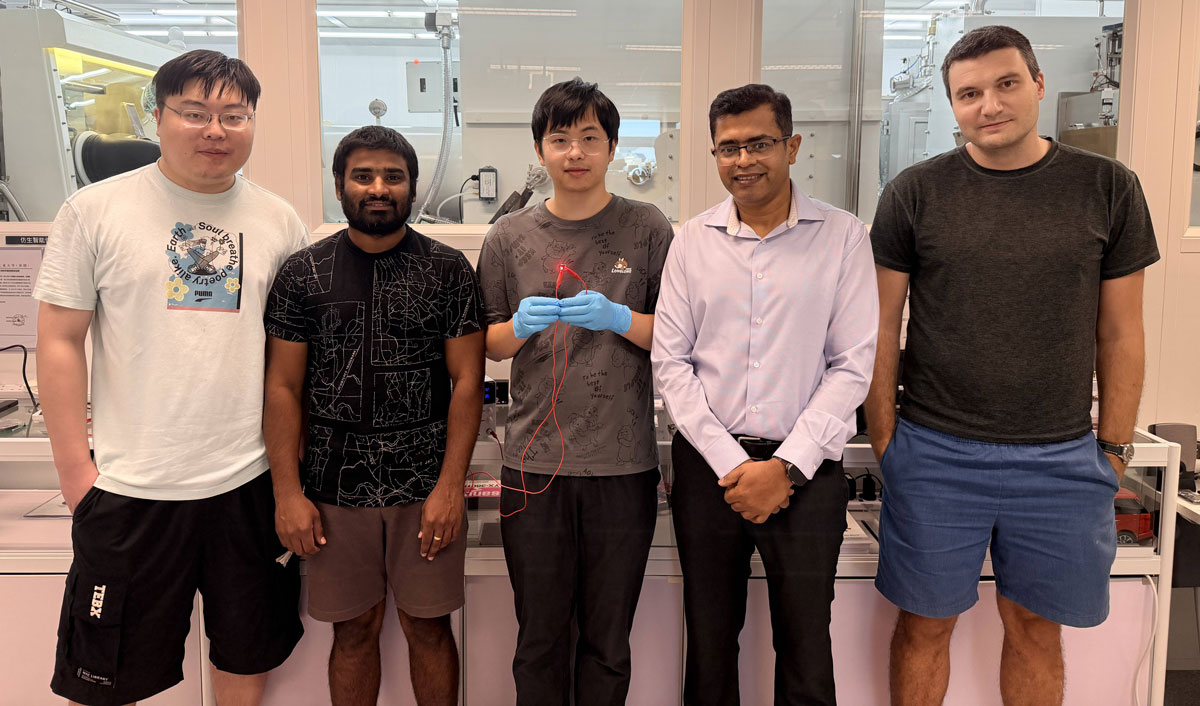News: LEDs
10 November 2025
HKUST develops record-efficiency red quantum rod LEDs
A research team led by the School of Engineering of The Hong Kong University of Science and Technology (HKUST) is said to have set a record efficiency level for red quantum rod light-emitting diodes (QR-LEDs), which could be applied to boost color vividness and brightness in next-generation display and lighting technologies for smartphones and TVs (Liao Zebing et al, ‘Inverted Device Engineering for Efficient and Bright Quantum Rod LEDs’, Advanced Materials; https://doi.org/10.1002/adma.202504559).

Picture: Sample of the red QR-LED with record efficiency.
Compared with existing mainstream LEDs, quantum dot LEDs (QD-LEDs) offer superior color purity (color vividness) and higher brightness. However, outcoupling efficiency has now become the primary obstacle, as it sets a fundamental ceiling for external quantum efficiency (EQE), hindering any further performance improvements.
As elongated anisotropic nanocrystals with unique optical properties, quantum rods can be engineered to optimize the light emission direction and ultimately improve outcoupling efficiency. However, QR-LEDs encounter two significant technical challenges: first, the ratio of emitted photons to absorbed photons (photoluminescence quantum yield) is relatively low after the material absorbs photons; second, there is a substantial leakage current due to poor thin-film quality.
To address these challenges, a research team led by professor Abhishek K. Srivastava, associate professor of the Department of Electronic and Computer Engineering (ECE), focused on boosting optical performance of QR-LEDs via refined synthesis engineering. They achieved photoluminescence quantum yield of up to 92% for both green and red quantum rods, along with uniform size distribution and shape confinement, all of which are essential for optimizing QR-LED performance.
In previous studies, the carrier leakage caused by irregular quantum rod films and its impact on diminishing the light coupling efficiency of QR-LEDs has often been overlooked. To tackle this issue, the team built an equivalent circuit model that illustrates the detrimental effects of leakage current in traditional QR-LED structures. This model provided valuable insights into the device’s operation, enabling the formulation of targeted solutions to suppress current leakage. By strategically transforming the QR-LED device structure, the team achieved a dual breakthrough: simultaneously enhancing balanced carrier injections and suppressing leakage current.
The results were remarkable – the optimized red QR-LEDs achieved a peak EQE of 31% and a peak brightness of 110,000cd.m-2, setting a new record in previous red QR-LED research. Moreover, to validate the universality of their strategies, the team applied the same approach to green ‘dot-in-rod’ quantum rods. The green devices reached a peak EQE of 20.2% and an ultra-high luminance of 250,000cd.m-2. These outcomes not only demonstrate the effectiveness of the innovations but also highlight their potential for application across different color variants of QR-LEDs.
“Previous QD-LED research primarily focused on optimizing quantum dot structures for high efficiency, but this approach does not apply to elongated shaped quantum rods, such as QR-LEDs,” notes Srivastava, the corresponding author of the study. “By utilizing equivalent circuit models and quantum rod micromorphology, we revealed that QR-LED have widespread pinholes due to their shape, which leads to critical leakage currents – an issue not encountered in tightly packed QD-LED. By modifying the device structure, we addressed the quality issues in emissive layer and verified fundamental advantages of quantum rod over quantum dots,” he adds. “This work is set to guide research on similar anisotropic nanocrystal and advance their commercial applications.”

Picture: The research team: corresponding author professor Abhishek K. Srivastava (second right); PhD student and first author Liao Zebing (center, holding a red-emitting QR-LED sample); and co-authors including postdoctoral fellow Dr Maksym Prodanov (first right), PhD students Mallem Kumar (second left) and Song Jianxin (first left).
Members of the team are from HKUST’s State Key Laboratory of Displays and Opto-Electronics, Center for Display Research, Department of Electronic and Computer Engineering (ECE) and Department of Physics, and collaborators from the University of Edinburgh, UK. The first author is ECE PhD student Liao Zebing, supervised by Srivastava.









